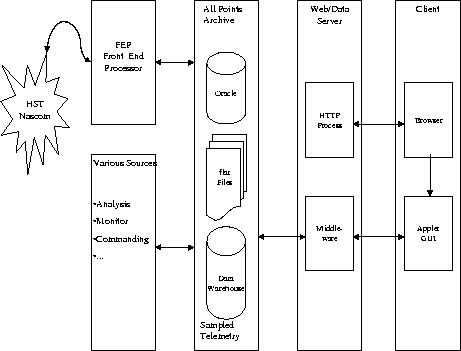 |
Next: An Archival System for Observational Data Obtained at the
Okayama and Kiso Observatories. III
Up: Archives and Information Services
Previous: Prototype of a Discovery Tool for Querying Heterogeneous Services
Table of Contents -- Index -- PS reprint -- PDF reprint
M. Miebach
European Space Agency, Space Telescope Science Institute,
3700 San Martin Drive, Baltimore, Maryland USA 21218
M. Dolensky
Space Telescope - European Coordinating Facility,
Karl-Schwarzschild-Str. 2, D-85748 Garching, Germany
Part of CCS is a Space Telescope Engineering Data Store, the design of which is based on modern Data Warehouse technology. The purpose of this data store is to provide a common data source for telemetry data for all HST subsystems. This data store will become the engineering data archive and will provide a query-able DB for the user to analyze HST telemetry. The access to the engineering data in the Data Warehouse is platform-independent from an office environment using commercial standards (Unix, Windows/NT, Win95). Latest Internet technology is used to reach the HST community. A WEB-based user interface allows easy access to the archives.
Some of the capabilities of CCS will be illustrated: sample of real-time data pages and plots of selected historical telemetry points.
A Web browser with Java support and an account to establish a secure Internet HTTP connection to the Goddard Space Flight Center (GSFC), is everything needed in order to use the new Control Center System (CCS). Then full access to the telemetry of the Hubble Space Telescope (HST) is given (Figure 2). A public version of CCS is also available.
How does that work? The telemetry data stream of HST is transfered to the Front End Processor (FEP) via Nascom (Figure 1). FEP provides a communication interface between the vehicle and ground control. It also captures all the downlinked data and forwards them to the attached All Points Archive. Besides the All Points Archive there is also the Red Brick Data Warehouse for sampled data. Without the warehouse the All Points Database containing several terabytes of telemetry parameters would be of limited use only. The warehouse samples data to reduce their size. In this way it is possible to further analyze them on standard platforms like Pentium PCs. The warehouse also provides derived engineering parameters and advanced query options. The warehouse is still under construction, but a Java applet prototype is already available at the home page of the Science & Engineering Systems Division (SESD) at STScI.
In order to support its heterogeneous clients and DB servers a three-tiered solution was chosen (Mickey, 1997). A Java applet on the client side speaks to a middleware component on the data server. The middleware then takes care of the DB access. Rifkin (1997) gives a more comprehensive description.
CCS's main task is not scientific data reduction. Nonetheless, it provides the means to develop e.g., new calibration algorithms. This is possible, because for the first time, one can have access to all engineering parameters via the Internet. So far, only a very limited subset of telemetry parameters is available through observation log files. One possible application is mentioned here to illustrate this.
The Faint Object Spectrometer (FOS) of the Hubble Telescope is an instrument that was replaced during the 2nd Shuttle Servicing Mission in February 97. As part of the final archive for this instrument, ST-ECF would like to apply an improved model of the geomagnetic field to the calibration pipeline. The required magnetometer readings from the onboard sensors are not part of the observation log files, but CCS could now provide the missing values. Figure 3 shows these magnetometer readings for a 5-hour-period, which equals roughly three HST orbits.
CCS will become operational in April 98. At this point it will provide all the functionality required for the 3rd Shuttle Servicing Mission in 1999. By the end of 1999 the data warehouse will be fully populated, i.e., it will contain the telemetry back to launch in 1990.
Many thanks to Jeff Johnson (Lockheed Martin) and Doug Spiegel (NASA) who never got tired answering questions and spent a lot of time on user support for CCS.
Rifkin, A. 1997, Reengineering the Hubble Space Telescope Control Center System, Institute of Electrical and Electronics Engineers Inc.
Mickey, S. 1997, Internet Java & ActiveX Advisor, Advisor Publications Inc., Vol. 4/94, p. 16-21
Next: An Archival System for Observational Data Obtained at the
Okayama and Kiso Observatories. III
Up: Archives and Information Services
Previous: Prototype of a Discovery Tool for Querying Heterogeneous Services
Table of Contents -- Index -- PS reprint -- PDF reprint